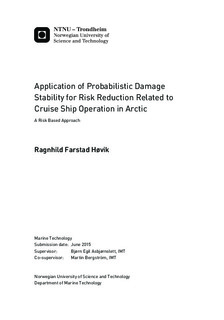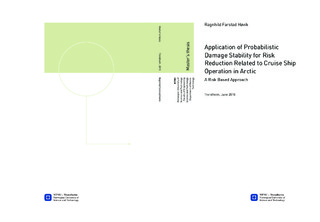| dc.description.abstract | The maritime activity in the Arctic waters has increased during the recent years due to diminishing ice and exploration of resources. Arctic operation involves an increased risk level all year around compared to operation in other open waters. The remoteness of the area and low temperatures can cause severe consequences if an accident would occur due to the possibilities for long waiting time for Search and Rescue (SAR) operations. For the cruise tourism industry the diminishing ice levels entail that more areas become accessible for exploration. The popular cruise tourism areas, around Svalbard, Franz Josef Land and the coast of Greenland are exposed to high concentration of icebergs and succeeding bergy bits and growlers. These smaller ice pieces pose large threats to the vessels operating in the area as they are difficult to detect and can induce large forces on the ship hull in case of impact. In order to ensure the safety of passengers and crew, it is necessary to evaluate measures for improved damage stability. In case of damage of the vessel resulting in water ingress, it is vital that measures have been taken to increase the vessel s capability to remain afloat. By increasing the survivability of the vessel, emergency evacuation can be avoided as the vessel function as it s own lifeboat .
Formal Safety Assessment (FSA) has been performed to assess the risk of cruise ship operation in Arctic, where probabilistic damage stability (PDS) and cost benefit assessment (CBA) is used to evaluate changes in the arrangement for risk reduction. Two risk control options (RCOs) have been developed on the basis of the general arrangement to MS Fram. Risk control option I considers implementation of longitudinal bulkheads in the forward area of the vessel, between the shell and crew cabins located between 1st and 2nd deck. A part of this area is located beneath the waterline, and is therefore exposed for damages caused by impact with drifting ice. Risk control option II considers changes in the arrangement for symmetrical flooding. The tanks located below tank top and below 1st deck are changed from heading in the longitudinal direction to the transverse direction. In case of damages to this area, implementation of RCO II ensures symmetrical flooding to improve the vessel s capability to remain afloat. The two RCOs have been implemented in the software DELFTShip, and compared with the initial arrangement on the basis of the probabilistic damage stability calculations. The increase in the attained index, as a result of the implemented RCOs, is considered as improved capability to remain afloat. The results from the PDS calculations show a slight increase in the attained index for both risk control options. This slight increased index improves the vessel s survivability by increasing the amount of damages where the time to capsize is longer than 30 minutes. The results from the cost benefit assessment show that both RCOs are cost effective and can thus be recommended for implementation.
The analyses are done based on numerous assumptions causing uncertainty regarding the accuracy of the results. However, the results are considered to give an indication on the effect of implementing the measures. Based on the results of the analyses, it is demonstrated that the measures for risk reduction can improve the damage stability of the vessel for cruise ship operation in Arctic | |

